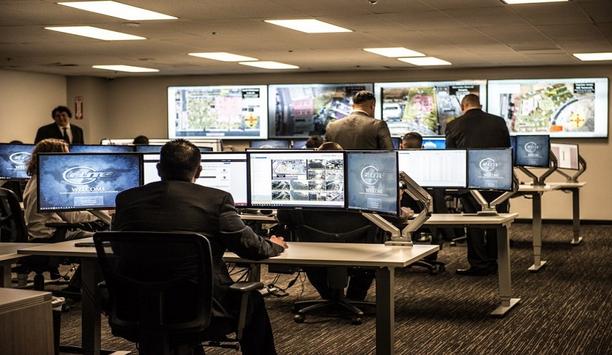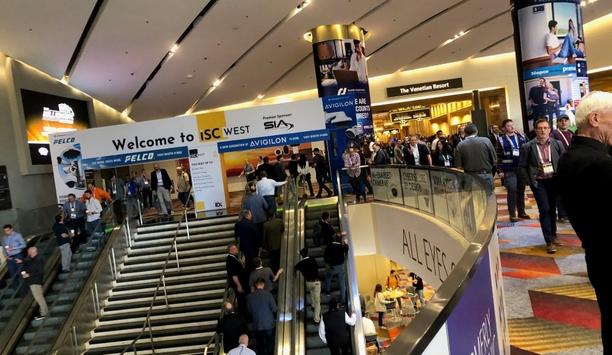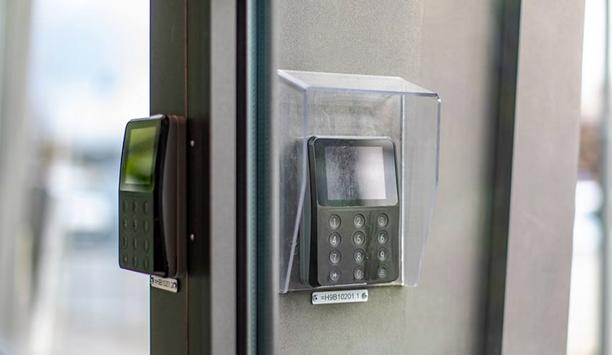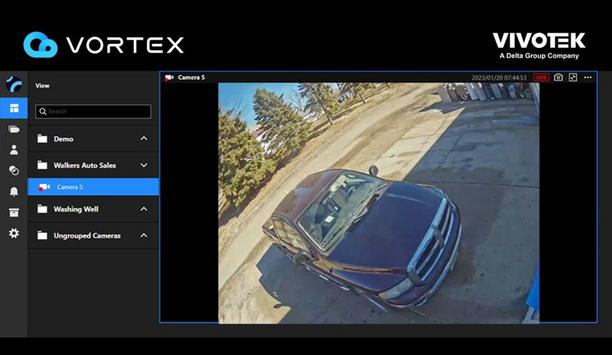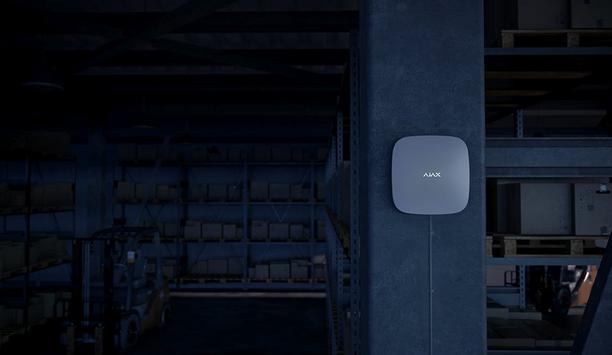Maritime security
SMARTSHOOTER, a world pioneer in fire control systems, will showcase its handheld and remotely controlled SMASH solutions at the DEFEA 2025 defence exhibition in Athens, Greece. The company will present its combat-proven SMASH 3000 Fire Control System and the SMASH Hopper Light Remotely Controlled Weapon Station (LRCWS), demonstrating advanced capabilities for counter-UAS (CUAS), maritime security, border defence, and perimeter protection. SMARTSHOOTER’s SMASH technology Combat-proven...
GOST® (Global Ocean Security Technologies), a world pioneer in marine security, tracking, monitoring and video surveillance systems, announced strategic company restructuring and leadership changes to better serve its customers and further expand the company’s reach around the world. GOST founder and Chief Technology Officer, Brian Kane will now lead the company as President and Chief Executive Officer, effective immediately. This new appointment comes as Jay Keenan transitions to the...
Smiths Detection, a pioneer in threat detection and security screening technologies, and a business of Smiths Group plc, announces it is to supply SDX 6040 X-ray inspection systems to a number of major cruise lines. With thousands of people and large quantities of cargo coming onboard, screening systems are vital in helping detect weapons, explosives, drugs, and other prohibited items hidden in luggage or supplies. SDX 6040’s portable and flexible design SDX 6040’s portable and fl...
Security Central is excited to announce the addition of Adam Emmett as our new Southeast Account Executive. With over 12 years of experience in the security industry, Adam brings a deep understanding of dealer success, emerging technology, and relationship-driven growth. Since beginning his career in security product manufacturing in 2013, Adam has built a strong reputation in the industry. A legacy of innovation With a passion for dealer growth and industry innovation, Adam bring...
ZE Government Solutions (ZEGS), a wholly owned subsidiary of A.I.-based gun detection pioneer ZeroEyes, announced it has partnered with HavocAI Inc., a pioneering innovator in autonomous uncrewed surface vessel technology, to deliver customised computer vision capabilities that will be integrated with HavocAI’s maritime autonomy platforms. HavocAI’s technology enables a single operator to command and control thousands of autonomous assets. The company's platform is designed to provi...
Cyberattacks are surging globally, with organisations now facing an average of 1,673 attacks per week – a staggering 44% increase from 2023. As AI-powered threats intensify and critical infrastructure such as energy systems become prime targets, CYBSEC-EXPO returns to Piacenza Expo in Italy with a renewed focus on education, collaboration, and cross-industry solutions. A stronger educational focus for 2025 CYBSEC-EXPO will feature an expanded conference programme between 21st&ndash...
News
Security Central is excited to announce the appointment of Dan Turner as its new Chief Technology Officer (CTO). With over 25 years of experience in the security industry, including a distinguished tenure as Chief Information Officer at Per Mar Security Services, Dan brings a wealth of expertise in information technology, cybersecurity, and business transformation to Security Central. Enhancing innovation in monitoring "Dan’s track record of innovation and his deep industry knowledge make him the perfect addition to our leadership team," said Caroline Brown, CEO of Security Central. "As we continue expanding our monitoring solutions, Dan’s expertise will be instrumental in enhancing our technology platforms, strengthening cybersecurity, and driving the future of intelligent security monitoring." Education and Leadership Dan holds academic experience from St. Ambrose University in Communication and Computer Science Beyond his professional achievements, Dan is a dedicated community member, serving on governing boards for local youth sports leagues and coaching football, baseball, basketball, and volleyball. His commitment to family and community makes Dan a natural fit for our team and aligns with our Core Values. He holds academic experience from St. Ambrose University in Communication and Computer Science, as well as Iowa State University, where he studied Chemical Engineering. He has also completed the Executive Integral Leadership program at the University of Notre Dame. Expanding Monitoring Solutions Dan joins Security Central at an exciting time as the company continues to push the boundaries of traditional monitoring services. His leadership will enhance the executive team allowing them to offer even greater solutions to the dealer network.
NSSLGlobal, a pioneering independent full-service project engineering, satellite communications and systems integrator, has appointed Andrew Burns as its new Group Sales Director to take the next step in its growth in the maritime, enterprise and defence sectors. Andrew brings over 35 years of global experience in sales and business development of solutions and services in the defence sector and will oversee the sales strategy of the group companies. Prior roles of Andrew Andrew’s background includes senior international management roles in commercial marine Andrew’s background includes senior international management roles in commercial marine and defence markets driving teams that ensure exceptional customer satisfaction as well as developing new markets. Having proven his ability at mentoring teams to increased order inflow across maritime markets while developing new defence verticals worth millions, Andrew had the ability to help businesses grow profitably. New opportunities and markets “I’m excited to join NSSLGlobal at such a dynamic point in its growth. Being part of a team so committed to its clients and innovation is a real privilege, and I look forward to building momentum, strengthening relationships, and uncovering new opportunities and markets to drive our success further,” says Andrew Burns. “We are delighted to welcome Andrew Burns to NSSLGlobal as our new Group Sales Director. Andrew’s proven track record in driving growth, his deep expertise in the commercial marine and defence sectors and his ability to lead high-performing teams will be invaluable as we continue to strengthen our presence in the maritime, enterprise, and defence markets,” says Sally-Anne Ray, Group CEO, NSSLGlobal.
The sensor solutions provider HENSOLDT and Abu Dhabi Ship Building (ADSB), an EDGE Group entity and regional pioneer in the design, construction, repair, maintenance, refit, and conversion of naval and commercial vessels, signed a Memorandum of Understanding (MoU) to explore collaboration opportunities in the development of advanced naval technologies. The agreement, signed during the International Defence Exhibition and Conference (IDEX 2025), held in Abu Dhabi from 17 to 21 February, aims to foster collaboration between the two companies in the field of naval technology. HENSOLDT’s advanced sensor solutions David Massey, CEO of ADSB, said: “Our partnership with HENSOLDT underscores our commitment to delivering breakthrough naval technologies." "By actively exploring new avenues for collaboration, we aim to integrate our shipbuilding expertise with HENSOLDT’s advanced sensor solutions, to meet the evolving demands of the maritime and naval defence sectors.” Quadome 3D Air and Surface Surveillance radar HENSOLDT radars, including the Quadome 3D Air and Surface Surveillance radar and the TRS-4D radar On his part, Russell Gould, Head of Group Global Business Development at HENSOLDT, added: “The naval domain is a cornerstone of our business success. The MOU with Abu Dhabi Ship Building enables HENSOLDT to offer state-of-the-art naval solutions to our customers, as well as expand our footprint in new markets.” HENSOLDT radars, including the Quadome 3D Air and Surface Surveillance radar and the TRS-4D radar, feature the latest software-defined Active Electronically Scanned Array (AESA) technology. TRS-4D product family Radars from the TRS-4D product family are already in service in various versions onboard German Navy vessels, including the F125 frigate and the K130 corvette. The company also offers a range of systems catering to the naval sector, including the Integrated Navigation Bridge System (INBS) and maritime electromagnetic warfare systems.
Sirius Insight announces that the Rt Hon Lord Reid of Cardowan has joined the company’s Advisory Board. In this role, Lord Reid will support Sirius Insight as the business seeks opportunities in international markets to deploy its transformative maritime domain awareness technology. Range of security-related portfolios Lord Reid was a Member of Parliament for over twenty years, during which time he served in Government Lord Reid was a Member of Parliament for over twenty years, during which time he served in Government across a range of security-related portfolios, including as Home Secretary, Secretary of State for Defence, Secretary of State for Northern Ireland, Transport Minister and Armed Forces Minister. Malcolm Glaister, Chief Executive Officer of Sirius Insight, said: “We are delighted to welcome Lord Reid on board as a senior advisor to Sirius, who has the stature and wealth of experience that only a former Home Secretary, Defence Secretary and Northern Ireland Secretary can possess." Opportunities in key international markets Glaister added: “Our business has grown at pace in recent times and Lord Reid’s appointment is both a vindication of that and a valuable addition to our team as the business pivots toward developing opportunities in key international markets, which will be the next crucial stage in our growth story.” The Rt Hon Lord Reid of Cardowan, Senior Advisor, said: “I’m delighted to be joining Sirius and supporting a business that’s focused on exporting impressive proprietary UK homegrown tech to international markets. Sirius have fashioned a first class and effective suite of products and services, embracing the potential AI can play in enhancing maritime safety and security, and I look forward to joining a vigorous and entrepreneurial team.”
Frequentis marks the debut of its LifeX3020 solution in Southeast Asia, improving emergency call handling and response coordination across three major centres and nationwide blue light agencies. This effort supports Malaysia’s Next Generation Emergency Services 999 (NG999) project, an upgrade designed to replace the current Malaysian Emergency Response System (MERS999). The initiative underscores Malaysia’s strong commitment to enhancing public safety across the nation. Responses from key agencies Frequentis will install innovative systems in three emergency response centres, the first deployment of its kind in Southeast Asia. These implementations will streamline emergency call handling, enabling quicker and more effective responses from key agencies such as police, fire, maritime, and civil defence services. “This project is an exciting opportunity to apply more than 25 years of expertise in public safety communications,” says Robert Nitsch, Vice President of Public Safety at Frequentis. “LifeX3020 is tailored to meet both current and future needs, ensuring that emergency services throughout Malaysia can provide fast, reliable, and efficient support to those in need.” Setup of 350 workstations Call takers will have improved tools to assess emergencies fast and direct help to the fit agencies The project involves the setup of 350 workstations across key emergency centres, backed by a robust infrastructure designed to enable rapid response across the nation. With the new platform, call takers will have enhanced tools to assess emergencies quickly and direct resources to the appropriate agencies without delay. This will significantly reduce response times, improving outcomes in critical situations. New benchmark for public safety technology Frequentis partners with local stakeholders to implement this large-scale project, which aligns with Malaysia’s broader efforts to strengthen national emergency services. The NG999 initiative sets a new benchmark for public safety technology in the region by integrating multiple services on a unified communication platform.
The International Maritime Cyber Security Organisation (IMCSO), an independent maritime standards organisation, has released its cybersecurity testing methodology for those maritime vessels looking to assess their risk and join the Cyber Risk Registry, a risk register database maintained by the IMCSO. The methodology aims to provide IMCSO-accredited cyber consultants and the senior maritime personnel they will be assessing with standardised testing by outlining test scope and the language to be used to ensure tests are planned, executed and reported effectively. Quality of cyber risk assessments “Currently there is no standard in the maritime sector for governing the quality of cyber risk assessments. This methodology will set a precedent by providing a set of criteria that assessors must observe when on engagement and against which maritime security can be measured." "It is a very big step forward in normalising both expectations and requirements in the maritime space,” said Campbell Murray, CEO at the IMCSO. Guide for cybersecurity practitioners The methodology stipulates the needs under which the cybersecurity checks will be carried out The methodology stipulates the conditions under which the cybersecurity assessments will be carried out. It acts as a legal and practical guide for cybersecurity practitioners who must adhere to the standards as a condition of their inclusion on the approved suppliers list, otherwise known as the Certified Supplier Registry, held by the IMCSO. The Captain and crew undergoing the assessment will also be required to abide by the methodology and undergo pre-assessment training to become cyber-ready in order to better understand the process and its findings. Operational technology standards Testing will assess security across ten categories under the umbrella term of Operational Technology (OT), i.e., the hardware and software needed to monitor and control the physical processes of the ship. These include navigation, propulsion, electrical systems, communication, safety systems, cargo handling, environmental systems, and maintenance systems, human factors, and regulatory and compliance issues. The assessment may be carried out at sea, onshore or a combination of the two. Currently, the only OT standards available to the sector are those associated with the manufacturing industry and very few directly assess OT. Cybersecurity posture In addition, it can often be difficult for shipping companies to objectively assess their OT suppliers In addition, it can often be difficult for shipping companies to objectively assess their OT suppliers, as Murray explains: “Third parties and the shipping companies share a dependency, with joint goals and integrated operations." "Yet, with supply chain attacks on the rise, they represent a real risk to operations. This can strain the relationship but by applying a systematic approach through a standardised risk assessment, the company can rely upon the process to vet the cybersecurity posture of their suppliers for them.” Key components of the IMCSO security testing methodology Pre-Requisites: Rules of engagement, authorisation, scope of work, objectives, zones of testing. Scope of Work: Outlines the project details and goals, signed by both parties. Rules of Engagement: Guidelines for testing, including permitted hours and restrictions. Authorisation and Legal Considerations: Compliance with laws and written stakeholder approval. Testing Methodology: The approach used (e.g., black-box, white-box). Deliverables: Expected outputs, such as reports and recommendations. Timelines: Start and end dates, with key milestones. Communication Plan: Points of contact and reporting protocols. Risk Management and Contingency Planning: Plans to mitigate potential risks like downtime or data loss. Confidentiality and Data Handling: Protecting sensitive data and results Testing Activity: Performed by qualified personnel, with prompt reporting of critical issues. Reporting: Clear and categorised reporting of security findings, including solutions. Report Delivery: Secure and confidential delivery of the final report. Cyber risk of the vessel Reports will take a practical method with clear advice made in response to any security issues Reports will take a practical approach with clear recommendations made in response to any of security issues or vulnerabilities. Outputs will be standardised under the methodology using qualitative metrics and this consistency will ensure the results for each vessel are comparable. The results will be used to profile the cyber risk of the vessel, the status of which will be recorded in the Cyber Risk Registry. Cyber risk trends within the maritime sector Shipowners are sensitive about sharing their vessel's data. The Cyber Risk Registry will serve as a valuable resource for stakeholders and relevant parties, including port authorities, insurance companies, and association partners, by providing insights into cyber risk trends within the maritime sector. Additionally, it will support the broader industry—including the IMO, shipbuilders, management companies, and industry associations—by offering a trusted registry of vendors, qualified practitioners, and service providers to help vessels strengthen their cyber resilience and mitigate risks effectively.


Expert commentary
The average business owner or investor has some kind of security precaution in place, especially in the after-hours when there are fewer deterrents to inhibit criminal activity. Security guards, video surveillance systems, motion sensor lights, or even just fake cameras placed around the property are some of the common options people choose. Future of overnight security Smart business owners are starting to realise, however, that some of these traditional security measures are becoming antiquated and no longer cutting. The now and future of overnight security is in remote guarding. Pioneered by companies like Los Angeles-based Elite Interactive Solutions, which was founded back in 2007, remote guarding is revolutionising the overnight security business. Minimising criminal activity Remote guarding is fast becoming the most popular choice among commercial end-user property owners Remote guarding utilises a combination of cutting-edge technology, “digital guards,” highly trained security agents, and local law enforcement if and when necessary to minimise the potential of criminal activity. For those adequately enlightened to its overwhelmingly impressive crime prevention capabilities, remote guarding is fast becoming the most popular choice among commercial end-user property owners to secure and protect their investments. What Is remote guarding? Remote guarding is a revolutionary concept and increasing trend in security systems that utilises a combination of methods to effectively analyse potential threats to property. Cameras and/or other monitoring devices running highly advanced algorithmic software are installed in strategic areas or vulnerable places onsite and remotely located security agents are immediately notified of any activity within a designated perimeter of the property. A blend of AI, cybersecurity, and video analytics When properly deployed by an expert provider, the technology stack includes a proprietary blend of video analytics, artificial intelligence, cybersecurity, and more. Done right, “noise” is effectively filtered out, allowing agents to act on legitimate alerts and achieve zero false alarms communicated to first responders. Today, there are a lot of terms and descriptions tossed around about remote guarding, remote video, virtual guarding, etc., but those attributes must be present to represent the true definition of the offering and its many virtues. Realtime situational awareness Many systems have a two-way speaker that allows the security agent to give a verbal warning When specially trained security agents are alerted to trespassers, possible intruders, or other suspicious activity, they analyse the situation in real-time and determine the necessary level of action. Many systems have a two-way speaker that allows the security agent to give a verbal warning, known as a voice-down, to the individual(s) that they are being watched. Most perpetrators, often believing the response is emanating directly from security personnel on the property itself rather than from a remote command centre, flee immediately. However, if the threat persists, the security agent enlists local law enforcement to get on the scene. Customised remote guarding When properly deployed, remote guarding systems are also customised to specific properties. A team of consultants visits the client’s property to evaluate its vulnerabilities and where to best place cameras and/or other monitoring devices for system efficacy. Traditional security shortfalls According to Keith Bushey, a retired commander for the Los Angeles Police Department, there is much frustration between law enforcement officers and potential victims of crime due to the historically unreliable performance of traditional burglar alarm systems and central monitoring stations. He states about 90% of security-related calls are false alarms, a problem that has been well-documented through the years. Onsite challenges When a legitimate emergency does occur, the perpetrators have often already done their damage When a legitimate emergency does occur, the perpetrators have often already done their damage and/or escaped by the time law enforcement arrives. Onsite security guards are not the remedy either as they bring their own set of issues and challenges. Unexpected costs Traditional security systems can also have unexpected costs. The cost is not only in the security guards’ paycheck or the cost of the equipment itself. The cost comes when an actual incident occurs. In worst-case scenarios, the security guard(s) are injured, the business suffers inventory loss, and/or damage is sustained to the property. The medical and other costs for the security guard(s), the loss of inventory, property damage, deployment of law enforcement resources, and possible fallout of legal expenses all add up. Even in the best-case scenario, false alarm expenses incur if law enforcement is dispatched. These, among many others, are some of the primary issues that remote guarding resoundingly answers as a superior alternative. A bounty of benefits Remote guarding systems have been proven to cut costs and be more effective than traditional security systems. Even though the monthly monitoring costs of remote guarding are significantly higher than traditional intrusion detection system monitoring, the much higher effectiveness in crime reduction, elimination of false alarms, and augmenting or replacement of manned guards result in a substantially higher return on investment (ROI) to the end user. Easy tracking of threats The security cameras already have their image captured on record, making them easier to track down For example, case studies have demonstrated reduced security costs for clients by 60%, on average. These reductions have come from the costs of security staff, inventory, or property loss, plus saving money on insurance premiums and deductibles. The nature of remote guarding reduces the risk and costs of false alarms, with professional security agents able to determine an actual threat before law enforcement is called. In a rare instance when a perpetrator escapes before law enforcement arrives or can detain the individual(s), the security cameras already have their image captured on record, making them easier to track down and identify. Reduction of false alarms The significant reduction in false alarms is greatly appreciated by law enforcement, as it allows them to focus on real emergencies or crises. Better relationships are also developed between clients and law enforcement, as remote guarding systems are highly reliable in providing accurate and real-time information to officers as they approach the scene. In short, it assists law enforcement in doing their job more effectively, as well as more safely thanks to having eyewitness information before engaging in an active crime scene. Partnership When you combine the decreased cost with the increased efficiency and success rate, it is easy to see why many commercial end-user property owners across the country are making the shift to remote guarding. It’s also an outstanding opportunity for professional security dealers and integrators to partner with a remote guarding services provider to bring a superior solution to their end customers and pick up a recurring monthly revenue stream in the process.
It’s no secret that the data security sector is constantly changing. It has an annual CGR of about 12.3%. Future trends in data security Much of this has to do with the rise of cybercrime in recent years, with reports showing that cyberattacks happen as often as every 39 seconds. To combat the growing rate of cybercrime, data security has been on the rise. As we journey further into this era, it becomes evident that a spectrum of significant trends is molding the future of data security. This exploration delves into a selection of these trends, unraveling their importance and the potential implications they carry 1. AI security tools will increase Artificial Intelligence is also being used in the development of smart attacks and malware The introduction of Artificial Intelligence in the data security industry brought significant changes, especially in cybersecurity. AI has been the golden standard for face detection, natural language processing, automated threat detection, and automated security systems. Additionally, Artificial Intelligence is also being used in the development of smart attacks and malware, bypassing even the latest security protocols in data control. And as time progresses, AI security tools will flourish and dominate the scene. Let’s take a more in-depth look at three of the top AI security tools. Targeted attack analysis tool Manufacturers utilise targeted attack analysis tools to uncover targeted and stealthy attacks. Artificial Intelligence can be applied to the program’s capabilities, processes, and knowledge. For instance, Symantec launched this tool to combat the Dragon 2.0 attack in 2022. The phishing attack reprimanded multiple energy companies while trying to gain access to their operational networks. Targeted Attack Analysis Tools can analyse incidents and look for similarities from previous situations. They also help detect suspicious activities and collect all the necessary data to determine whether a specific action is malicious. Intercept X tool Results from the Intercept X Tool feature high accuracy and a low false positive rate Sophos, a British security hardware and software company, launched the Intercept X Tool. It engages a neural network that records and analyses data like a human brain. Sophos’ Intercept X Tool can extract features from a single file and perform a deep analysis. It detects malicious activities within 20 milliseconds. Plus, it’s also trained to work on bi-directional sharing and real-world feedback of threat intelligence. Results from the Intercept X Tool feature high accuracy and a low false positive rate. IBM Watson Technology IBM’s QRadar Advisor uses IBM Watson Technology, a unique AI tool for fighting cyber attacks. Artificial Intelligence can auto-investigate activities and indicators for potential exploitation or compromise. With cognitive reasoning, IBM Watson Technology can present critical insights to accelerate the response cycle. Security analysts can utilise this technology to search for threat incidents, reducing the risk of letting them fly under the radar. 2. Blockchain as a security solution It guarantees no points of failure or hackable entrances that can expose datasets inside the system Blockchain is a type of distributed ledger technology (DLT) that aims to establish trust within an untrusting ecosystem. Today it’s one of the most robust cybersecurity technologies in the industry. Blockchain utilises a decentralised ledger system, but your team members can still gain access to transparent information in the cloud. Members can also record, pass along, and view necessary transactional data in the blockchain. The entire blockchain process maintains data integrity within the system while establishing trust among team members. It guarantees no points of failure or hackable entrances that can expose datasets inside the system. Cybersecurity, biometrics Cybersecurity primarily benefits from these features because blockchain can create a secure and robust wall between data and hackers. On top of that, blockchain ledgers can include biometrics like fingerprints and retina scans. These prevent hackers from accessing any private data. Because blockchain is decentralised, it also limits hackable data. Together with the technology’s record-keeping system, each node is provided insight into data manipulation exposing real-time cybercrime attempts. 3. Increased and widened access control Without access control, expect your company to be open to security issues, including theft, data loss, and breach of data Access control is critical in data security. More than a valuable security tool, business leaders can use access control to regulate people accessing any given resource. A company with an IT security setting can control who has the liberty to edit certain files. One of the primary goals of access control is to minimise threats or attacks to organisations and businesses to keep people and data secure. Without access control, expect your company to be open to security issues, including theft, data loss, and breach of data protection laws. Benefits The benefits of increased and widened access control include: Identifying who can access and control your data at specific time intervals. Protecting data from overwriting, accidental deletion, and malicious intent. User permissions that can be readily changed. Compliance and regulation with data privacy laws. Central management of access to data through a reporting portal or a dashboard. Multi-factor authentication Access control comes in various types and systems, so it’s critical to know the features of what you’re looking for. The most common type is multi-factor authentication or MFA. It involves multiple steps before logging in, requiring the user to enter other relevant information besides the password. Some other examples of information include biometrics, answering a security question, or entering a code sent to the user’s email address. Two-factor authentication, role-based access control Two-factor authentication further prevents unauthorised entries that can result in unnecessary data possession Two-factor authentication further prevents unauthorised entries that can result in unnecessary data possession. Another type of access control is role-based access control. In this setup, only one individual can set up access guidelines and grant permissions to specific team members within an organisation. 4. Greater use of the zero-trust security model The zero-trust security model is a framework that requires every user within and outside the organisation to undergo authentication, authorisation, and validation. These are all essential to ensure proper security configuration before access is granted to the company’s applications and data. A zero-trust model assumes that anyone can cause data breaches and that a traditional network edge is not taken into effect. Moreover, it addresses the following modern-day challenges: Hybrid cloud environments. Security of remote workers. Ransomware threats. This framework utilises the combination of multiple advanced technologies, including: A risk-based multi-factor authentication. Endpoint security. Identity protection. Cloud workload technology. The zero-trust model uses all these innovative tools for system identification, user verification, access consideration, and system security maintenance. Constant validation and monitoring Enforcing strict policies and compliance with data privacy laws are also essential Additionally, it also considers data encryption, email security, and asset verification before establishing connections with applications. The architecture of a zero-trust framework requires constant validation and monitoring of the users and the devices they are using. Enforcing strict policies and compliance with data privacy laws are also essential. More importantly, the zero trust architecture requires all organisations to be aware of all their available services and accounts to gain complete control of data handling and manipulation. 5. Increased privacy regulations Privacy regulations and policies guide organisations in proper data control, handling, and security. These policies guide organisations in proper data control, handling, and security. As a responsible business owner, you must comply with these regulations to avoid legal issues. With cybersecurity attacks becoming common, expect increased and stricter privacy regulations to be released in the next few years. While current policies are still taken into effect, various modifications and adjustments will occur to compete with the rising numbers of data breaches, thefts, data loss, and more. California Privacy Rights Act (CPRA) Currently, the California Privacy Rights Act (CPRA) is the most comprehensive legislation on state data privacy. It only started to take effect on January 1, 2023. The CPRA introduces the following principles: Broad individual consumer rights. Significant duties of people who need to collect sensitive and personal information. Additional definitions of data privacy and security. An individual’s duties include releasing information about data collection to concerned data subjects and proper access, correction, and deletion of information. Final thoughts 2023 is a big year for data security. Trends such as increased adoption of zero-trust policies, a greater reliance on AI security tools, and the implementation of blockchain as a security solution are all things we expect to see shortly. Staying up-to-date with these trends is important for keeping your business current and ensuring that you’re adhering to new and changing regulations. Doing so can give you an edge over the competition and keep you out of legal hot water.
Global transportation networks are becoming increasingly interconnected, with digital systems playing a crucial role in ensuring the smooth operation of ports and supply chains. However, this reliance on technology can also create vulnerabilities, as demonstrated by the recent ransomware attack on Nagoya Port. As Japan's busiest shipping hub, the port's operations were brought to a standstill for two days, highlighting the potential for significant disruption to national economies and supply chains. Transportation sector The attack began with the port's legacy computer system, which handles shipping containers, being knocked offline. This forced the port to halt the handling of shipping containers that arrived at the terminal, effectively disrupting the flow of goods. The incident was a stark reminder of the risks associated with the convergence of information technology (IT) and operational technology (OT) in ports and other critical infrastructures. This is not an isolated incident, but part of a broader trend of escalating cyber threats targeting critical infrastructure. The transportation sector must respond by bolstering its defences, enhancing its cyber resilience, and proactively countering these threats. The safety and efficiency of our transportation infrastructure, and by extension our global economy, depend on it. Rising threat to port security and supply chains XIoT, from sensors on shipping containers to automatic cranes, are vital to trendy port functions OT, once isolated from networked systems, is now increasingly interconnected. This integration has expanded the attack surface for threat actors. A single breach in a port's OT systems can cause significant disruption, halting the movement of containers and impacting the flow of goods. This is not a hypothetical scenario, but a reality that has been demonstrated in recent cyberattacks on major ports. Adding another layer of complexity is the extended Internet of Things (XIoT), an umbrella term for all cyber-physical systems. XIoT devices, from sensors on shipping containers to automated cranes, are now integral to modern port operations. These devices are delivering safer, more efficient automated vehicles, facilitating geo-fencing for improved logistics, and providing vehicle health data for predictive maintenance. XIoT ecosystem However, the XIoT ecosystem also presents new cybersecurity risks. Each connected device is a potential entry point for cybercriminals, and the interconnected nature of these devices means that an attack on one, which can move laterally and can have a ripple effect throughout the system. The threat landscape is evolving, with cybercriminals becoming more sophisticated and their attacks more damaging with a business continuity focus. The growing interconnectivity between OT and XIoT in port operations and supply chains is also presenting these threat actors with a greater attack surface. Many older OT systems were never designed to be connected in this way and are unlikely to be equipped to deal with modern cyber threats. Furthermore, the increasing digitisation of ports and supply chains has led to a surge in the volume of data being generated and processed. This data, if not properly secured, can be a goldmine for cybercriminals. The potential for data breaches adds another dimension to the cybersecurity challenges facing the transportation sector. Role of cyber resilience in protecting service availability Cyber resilience refers to organisation's ability to prepare for, respond to, and recover from threats As the threats to port security and supply chains become increasingly complex, the concept of cyber resilience takes on a new level of importance. Cyber resilience refers to an organisation's ability to prepare for, respond to, and recover from cyber threats. It goes beyond traditional cybersecurity measures, focusing not just on preventing attacks, but also on minimising the impact of attacks that do occur and ensuring a quick recovery. In the context of port operations and supply chains, cyber resilience is crucial. The interconnected nature of these systems means that a cyberattack can have far-reaching effects, disrupting operations not just at the targeted port, but also at other ports and throughout the supply chain. A resilient system is one that can withstand such an attack and quickly restore normal operations. Port operations and supply chains The growing reliance on OT and the XIoT in port operations and supply chains presents unique challenges for cyber resilience. OT systems control physical processes and are often critical to safety and service availability. A breach in an OT system can have immediate and potentially catastrophic physical consequences. Similarly, XIoT devices are often embedded in critical infrastructure and can be difficult to patch or update, making them vulnerable to attacks. Building cyber resilience in these systems requires a multi-faceted approach. It involves implementing robust security measures, such as strong access controls and network segmentation, to prevent attacks. It also involves continuous monitoring and detection to identify and respond to threats as they occur. But perhaps most importantly, it involves planning and preparation for the inevitable breaches that will occur, ensuring that when they do, the impact is minimised, and normal operations can be quickly restored. Building resilience across port security and supply chains In the face of cyber threats, the transport sector must adopt a complete method of cybersecurity In the face of escalating cyber threats, the transportation sector must adopt a comprehensive approach to cybersecurity. This involves not just implementing robust security measures, but also fostering a culture of cybersecurity awareness and compliance throughout the organisation. A key component of a comprehensive cybersecurity strategy is strong access controls. This involves ensuring that only authorised individuals have access to sensitive data and systems. It also involves implementing multi-factor authentication and regularly reviewing and updating access permissions. Strong access controls can prevent unauthorised access to systems and data, reducing the risk of both internal and external threats. Network segmentation Network segmentation is another crucial measure. By dividing a network into separate segments, organisations can limit the spread of a cyberattack within their network. This can prevent an attack on one part of the network from affecting the entire system. Network segmentation also makes it easier to monitor and control the flow of data within the network, further enhancing security. Regular vulnerability assessments and patch management are also essential. Vulnerability assessments involve identifying and evaluating potential security weaknesses in the system, while patch management involves regularly updating and patching software to fix these vulnerabilities. These measures can help organisations stay ahead of cybercriminals and reduce the risk of exploitation. EU’s NIS2 Directive EU’s NIS2 Directive came into effect, and member states have until October 2024 to put it into law The transportation sector must also be prepared for greater legislative responsibility in the near future. The EU’s NIS2 Directive recently came into effect, and member states have until October 2024 to put it into law. The Directive aims to increase the overall level of cyber preparedness by mandating capabilities such as Computer Security Incident Response Teams (CSIRTs). Transport is among the sectors labelled as essential by the bill, meaning it will face a high level of scrutiny. Getting to grips with the complexities of XIoT and OT integration will be essential for organisations to achieve compliance and avoid fines. Global transportation infrastructure Finally, organisations must prepare for the inevitable breaches that will occur. This involves developing an incident response plan that outlines the steps to be taken in the event of a breach. It also involves regularly testing and updating this plan to ensure its effectiveness. A well-prepared organisation can respond quickly and effectively to a breach, minimising its impact and ensuring a quick recovery. In conclusion, mastering transportation cybersecurity requires a comprehensive, proactive approach. It involves implementing robust technical measures, fostering a culture of cybersecurity awareness, and preparing for the inevitable breaches that will occur. By taking these steps, organisations can enhance their cyber resilience, protect their critical operations, and ensure the security of our global transportation infrastructure.
Security beat
Fueled by mounting concerns about the cybersecurity vulnerability of U.S. ports, President Joe Biden has signed an Executive Order aimed at shoring up defences against cyberattacks. Cybersecurity initiative The cybersecurity initiative marks a significant shift in policy, empowering key agencies and outlining concrete actions to bolster defences. By empowering agencies, establishing clear standards, and fostering collaboration, the initiative aims to strengthen U.S. ports against the evolving threat of cyberattacks, safeguarding the nation's maritime economy and national security. Expanded authority for DHS The proactive approach aims to prevent incidents before they occur The Executive Order grants expanded authority to the Department of Homeland Security (DHS) and the Coast Guard to address maritime cyber threats. DHS gains the power to directly tackle these challenges, while the Coast Guard receives specific tools. The Coast Guard can compel vessels and waterfront facilities to address cyber vulnerabilities that endanger safety. The proactive approach aims to prevent incidents before they occur. Real-time information sharing Reporting any cyber threats or incidents targeting ports and harbors becomes mandatory. This real-time information sharing allows for swifter response and mitigation efforts. The Coast Guard also gains the authority to restrict the movement of vessels suspected of posing cyber threats. Inspections can be conducted on vessels and facilities deemed risky. Mandatory cybersecurity standards The standardisation aims to eliminate weak links in the chain and prevent attackers from exploiting Beyond these broad powers, the Executive Order establishes foundational elements for improved cybersecurity. Mandatory cybersecurity standards will be implemented for U.S. ports' networks and systems, ensuring a baseline level of protection across the board. This standardisation aims to eliminate weak links in the chain and prevent attackers from exploiting individual vulnerabilities. Importance of collaboration and transparency Furthermore, the initiative emphasises the importance of collaboration and information sharing. Mandatory reporting of cyber incidents fosters transparency and allows government agencies and private sector partners to work together in mitigating threats. Additionally, the Executive Order encourages increased information sharing among all stakeholders, facilitating a unified response to potential attacks. Maritime Security Directive The Executive Order encourages investment in research and development for innovative cybersecurity solutions To address specific concerns, the Coast Guard will issue a Maritime Security Directive targeting operators of Chinese-manufactured ship-to-shore cranes. This directive outlines risk management strategies to address identified vulnerabilities in these critical pieces of port infrastructure. The long-term success of this initiative hinges on effective implementation. The Executive Order encourages investment in research and development for innovative cybersecurity solutions, recognising the need for continuous improvement and adaptation to evolving threats. Recognising the urgency of cyber threats The initiative has been met with widespread support from port authorities, industry stakeholders, and cybersecurity experts who recognise the urgency of addressing cyber threats. However, some concerns exist regarding the potential burden of complying with new regulations for smaller port operators. Effective communication, resource allocation, and collaboration among all stakeholders will be crucial to ensure the successful implementation of this comprehensive plan. Enhancing cybersecurity The more impactful and noteworthy piece is the associated NPRM from the U.S. Coast Guard (USCG) “This Executive Order is a positive move that will give the U.S. Coast Guard (USCG) additional authority to enhance cybersecurity within the marine transportation system and respond to cyber incidents,” comments Josh Kolleda, practice director, transport at NCC Group, a cybersecurity consulting firm. The more impactful and noteworthy piece is the associated Notice of Proposed Rulemaking (NPRM) from the U.S. Coast Guard (USCG) on “Cybersecurity in the Marine Transportation System,” adds Kolleda. Portions of the notice of proposed rulemaking (NPRM) look similar to the Transportation Security Administration (TSA) Security Directive for the rail industry and the Emergency Amendment for the aviation industry. Coordinating with TSA on lessons learned The USCG should be coordinating with TSA on lessons learned and incorporating them into additional guidance to stakeholders and processes to review plans and overall compliance, says Kolleda. “At first glance, the NPRM provides a great roadmap to increase cybersecurity posture across the various stakeholders, but it underestimates the cost to private companies in meeting the requirements, particularly in areas such as penetration testing,” says Kolleda. Cyber espionage and threats The focus is on PRC because nearly 80% of cranes operated at U.S. ports are manufactured there “It is unclear if or how the federal government will provide support for compliance efforts. As this seems to be an unfunded mandate, many private companies will opt for the bare minimum in compliance.” “Cyber espionage and threats have been reported by the Director of National Intelligence from multiple nation-states including China, Russia, and Iran,” adds Paul Kingsbury, principal security consultant & North America Maritime Lead at NCC Group. The focus here is on the People’s Republic of China (PRC) because nearly 80% of cranes operated at U.S. ports are manufactured there, he says. Destructive malware “The state-sponsored cyber actors’ goal is to disrupt critical functions by deploying destructive malware resulting in disruption to the U.S. supply chain,” says Kingsbury. “These threat actors do not only originate in China or other nation-states but also include advanced persistent threats (APTs) operated by criminal syndicates seeking financial gain from such disruptions." "The threat actors don’t care where the crane was manufactured but rather seek targets with limited protections and defences. The minimum cyber security requirements outlined within the NPRM should be adopted by all crane operators and all cranes, regardless of where they are manufactured.” PRC-manufactured cranes Kingsbury adds, “The pioneering risk outlined in the briefing is that these cranes (PRC manufactured) are controlled, serviced, and programmed from remote locations in China." "While this is a valid concern and should be assessed, there are certainly instances where PRC-manufactured cranes do not have control systems manufactured in PRC. For example, there are situations in maritime transportation system facilities where older cranes have been retrofitted with control systems of European Union or Japanese origin.” Monitoring wireless threats “The Biden Administration’s recent Executive Order is a critical step forward in protecting U.S. ports from cyberattacks and securing America’s supply chains,” says Dr. Brett Walkenhorst, CTO at Bastille, a wireless threat intelligence technology company. “To ensure proper defence against malicious actors accessing port-side networks, attention must also be paid to common wireless vulnerabilities." "Attacks leveraging Wi-Fi, Bluetooth, and IoT protocols may be used to access authorised infrastructure including IT and OT systems. Monitoring such wireless threats is an important element in a comprehensive approach to upgrading the defences of our nation’s critical infrastructure.”
Well attended and generating levels of excitement not seen since before the pandemic, ISC West may provide just the shot of adrenaline we need to drive industry success through the uncertain economic times ahead. Buzzwords like artificial intelligence (AI) and the cloud were still prevalent at the conference and exhibition in Las Vegas, but the hype of yesteryear seemed more subdued. Rather than breakthroughs to be celebrated, AI and cloud were discussed more as ways systems can realise even greater potential. Rampant cybersecurity attacks Rather than hype, discussions seemed much more practical and down-to-earth, encompassing shifting customer needs and how to address pain points. There was more discussion of the shift of security from a cost center to a profit center, where industry technologies can contribute to an enterprise’s bottom line. More companies seemed to be vigorously addressing the challenges of cybersecurity More companies seemed to be vigorously addressing the challenges of cybersecurity, although perpetually an obstacle. The industry seems more devoted than ever to protecting physical security systems in an age of rampant cybersecurity attacks. But more than in years past, it was the ISC West event itself that generated the most buzz. The crowded aisles of the exhibition seemed both reminiscent of the pre-covid past and prescient of the industry’s even brighter future. From booth to booth and attendee to attendee, the enthusiasm was both conspicuous and contagious. Everybody was thinking: ‘Wow! What a show!’ Pushing technology to the edge “The practice of physical security is about more than understanding threats, and end users are thinking now about the bigger picture of security and how networks work in the broader context of the business,” said Andrew Elvish, Vice President, Marketing at Genetec. Problems of latency and miscommunication are elements pushing technology to the network edge, he says. For example, in an access control scenario, decision-making should be as close to the door as possible to avoid network congestion, delays, or failure. Andrew Elvish, Vice President, Marketing at Genetec, displays Axis network door controller ‘powered by Genetec’ Elements pushing technology Reflecting the philosophy is a new collaboration introduced at the show called ‘Axis Powered by Genetec,’ an enterprise-level access control offering that combines Genetec Synergis software with A1210 and A1610 network door controllers by Axis Communications. Elvish says lines are blurring when it comes to edge versus cloud technologies. Rather than choosing ‘either-or,’ a blending of approaches is optimum, always ensuring that “Decision-making is close to the point of actuation,” he says. On-premise versus cloud systems Elvish also points to changing assumptions about the industry roles of on-premise versus cloud systems Elvish also points to changing assumptions about the industry roles of on-premise versus cloud systems. Historically, the assumption was that on-premise systems are most appropriate for enterprise customers, while the cloud is the best approach for small- to medium businesses (SMBs). Depending on the end customer’s needs, a system can be either or both at the same time. Rather than debate cloud versus edge, customers should consider the outcomes they seek, and how technologies can be merged to provide those outcomes. “They should consider a solution where they do both, with the gradation of controls provided at their fingertips,” says Elvish. Combining security into one platform Unifying security and related functions on a single platform was a widely evident trend at ISC West. An example is Verkada which now offers a unified platform that includes video, access control, and intrusion detection, as well as other functions such as air quality sensors, visitor management, and a door intercom. David Tsang, Product Director of Verkada, predicts demand to combine technologies into a single platform will grow in the industry. Furthermore, as data is collected in the single system, enterprises will find new ways to ‘connect the dots’ to provide better business intelligence. Air quality sensors Verkada’s cloud-based system enables fast deployment of the single platform “Our approach to building products is based around the idea that every company has different needs, and they want technologies to integrate seamlessly and operate off the same platform,” says Tsang. In addition to seamless integration, each product must also be able to stand on its own. Tsang manages Verkada’s various product categories, including access control, air quality sensors, intercoms, etc. Verkada’s cloud-based system enables fast deployment of the single platform, and the company works with dealers to ensure delivery of a 'better partner experience.' What happens after a binge of acquisitions? Acre Security unveiled a new corporate ‘identity’ and a big booth highlighting the technology brands the company has acquired over the last several years. Brands such as Feenics, ACTMobile, Comnet, Razberi, and others reflect Acre’s acquisition of these companies but are now being promoted as technology choices under the ‘one Acre’ approach. Don Joos, CEO of Acre Security, looked ahead to the future of the company at ISC West Visitor management product categories Change is in the air, and the booth’s unified visual design signifies the new direction for the company, says Don Joos, Acre’s CEO. Various technologies can be delivered via the cloud, through an on-premise installation, or using a hybrid approach Acre is highlighting ACTMobile’s mustering capability, useful in the K-12 market In tying technologies together, the ACTMobile product will play a key role in two major verticals -- command-and-control and K-12 schools. Acre is highlighting ACTMobile’s mustering capability, useful in the K-12 market, which was adapted from a technology used in the cruise industry. The Acre approach is to embrace the variety of opportunities available in the access control, intrusion, and visitor management product categories within a broad definition of ‘security’ that embraces both core capabilities and ‘adjacencies,’ says Joos. Acre seeks to enable customers to protect people, facilities, and critical assets. They manage customers’ security data and provide the insights they need. Ensuring a cohesive security system A challenge in the industry is combining various single products into a cohesive whole. “There are many products that do one thing well, but it’s harder to build a cohesive security platform,” says Ryan Schonfeld, Founder and CEO of Hivewatch. Hivewatch is a software platform that performs the functions previously associated with a ‘PSIM,’ which is a physical security information management system. The term PSIM has earned a questionable reputation in the industry, plagued by added costs and the perpetual challenges of integrating with ever-changing software platforms. Information management system Hivewatch seeks to bypass other software systems and to integrate as closely as possible with devices Hivewatch seeks to bypass other software systems and to integrate as closely as possible with devices on the edge, thus avoiding the impact of software system changes. They integrate with data in a ‘different way’ that eliminates the need to conform to other software systems. In today’s climate, the term ‘security’ could be seen as limiting when it comes to the various functions our industry’s systems can perform in the broader enterprise, says Schonfeld. Traditional enterprise reporting structures that have physical security reporting to the facilities or real estate department are limiting the broader role security can play in the enterprise. Positioning physical security Changing norms are positioning physical security to report to the CIO or CISO, thus reflecting physical security’s role in collecting and analysing data. Higher visibility within the enterprise can help security expand its influence and impact. “Security is too limiting, and it can keep us from getting a seat at the table,” says Schonfeld. “We need to shift from being a cost center to generating revenue and/or driving business — and data is the key. Rather than leading by fear, we need to show the value security can drive.”
Case studies
Alarming increases in vehicle thefts, unsolved traffic collisions, and stolen cargo in the Mexican State of Tlaxcala, motivated the Executive Commission of the State Public Security System (CESESP) to expand and upgrade its video security system. To counter the rise in crime, the CESESP sought a flexible, scalable, open-platform video management system (VMS) that could seamlessly incorporate existing cameras as well as over 800 new cameras and edge devices from a range of hardware and software providers. Tlaxcala Located in East-Central Mexico, Tlaxcala is one of 32 states within the Federal Entities of Mexico. With a population of approximately 1,343,000, based on the 2020 census, Tlaxcala is the smallest yet one of the most densely populated states in Mexico. The CESESP of Tlaxcala is tasked with safeguarding residents across the state's 60 municipalities. C4 centre C4 centre has multiple teams of six security professionals who monitor the system around the clock At the core of all security operations, including the 911 emergency response and 089 confidential tip line, is the CESESP's Control, Command, Communications, and Computing centre (C4). The state’s C4 centre has multiple teams of six security professionals who monitor the system around the clock on a large, 24-screen video wall. The C4 also houses the system’s HP and Lenovo servers. Flexibility, scalability, and budget “Flexibility, scalability, and strictly adhering to the budget were top requirements for this critical, state-wide project,” said Maximino Hernández Pulido, Executive Commissioner of the State Public Security System. “We considered a variety of proposals and providers, but we ultimately followed the advice of our integrator, Digital Information Systems, and selected XProtect Corporate from Milestone Systems.” XProtect Corporate The new system includes cameras from Hanwha Vision, Bosch Security and Safety Systems, Hikvision, and Pelco The new system includes cameras from Hanwha Vision, Bosch Security and Safety Systems, Hikvision, and Pelco, all integrated within the system and managed by XProtect Corporate VMS from Milestone Systems. The system is also fully integrated with the BriefCam Video Analytics Platform, delivering video intelligence for system managers to identify, monitor, investigate, and visualise incidents plus video data to make smarter decisions. Efficient and cost-effective integration “Because state officials rely on their video system 24/7, the update needed to be gradual with no downtime. As new cameras were integrated into the Milestone platform, the previous system slowly disappeared,” said Isaac Sánchez Morales, an engineer at Digital Information Systems (SDI), an integrating company. “The XProtect Corporate open platform VMS allowed us to leverage our existing cameras and servers, integrate new equipment and devices, making the process very efficient and cost-effective, and we never had a gap in service.” Data-driven video for fast response times BriefCam video analytics technology The solution detects, identifies, and classifies video metadata to drive more efficient investigations The BriefCam video analytics technology seamlessly integrates into Milestone’s XProtect Smart Client. The solution detects, identifies, and classifies video metadata to drive more efficient investigations and business decisions, such as finding missing persons, investigating the vandalism, theft, assaults, accidents, injuries, or acts of violence, as well as extracting and analysing through heatmaps, dashboards, and visualisations. The analytics have proven beneficial in accelerating investigations, attaining situational awareness, and optimising operational intelligence for enhanced video search, alerting, and data visualisation. Real-time alerts, situational awareness “We installed the BriefCam Insights and Investigator products, and regularly use the platform’s RESPOND and RESEARCH capabilities. One of the advantages of all these XProtect-integrated analytics is that operators do not have to open additional windows or enter new credentials to access them,” said Sánchez. “With this integration of technologies, operators can trigger real-time alerts based on complex object classifications and filter combinations to increase situational awareness meaning authorities can react to events as they unfold.” Proactive policing with LPR With the BriefCam RESPOND solution, object characteristics and licence plate recognition tools can be used" Sánchez added, "With the BriefCam RESPOND solution, object characteristics such as a vehicle, person, or animal, and licence plate recognition tools can be used to trigger rule-based alerts." "These tools can help overcome the challenges of urban video surveillance and drive proactive policing in Tlaxcala." Video technologies reduce state crime rates Following the comprehensive expansion of the security infrastructure, statistics from the Executive Secretariat of the National Public Security Systems revealed Tlaxcala boasted the lowest crime rate nationwide. With the modernised system in place, officials documented a 93% reduction in pilfered freight from transport companies. Similarly, vehicle theft declined by 22.5%. A cost-efficient and flexible way Milestone Interconnect provides a cost-efficient and flexible way to gain central surveillance According to Sánchez and the SDI team, it is expected that each municipality within the territory will soon have its own locally focused VMS. With the use of Milestone Interconnect, all the municipality subsystems will integrate directly with the state-wide platform. Milestone Interconnect provides a cost-efficient and flexible way to gain central surveillance of multiple sites spread across a region. C4 video surveillance operation “The integrated solution delivered through Milestone is a robust, efficient, and secure system that provides all the necessary tools for the C4 video surveillance operation,” added Executive Commissioner Hernández-Pulido. “In addition, the excellent technical and post-sales support from Milestone and SDI has led us to meet the system and performance goals we set for ourselves.”
SystemHouse Solutions' security system Integra and the graphical presentation interface Artifex will be installed at Kriminalvården's custody centres in Helsingborg, Gothenburg, and Sollentuna. The installation includes a total of 765 custody cells and means that SystemHouse Solutions strengthens its position as one of the major security producers in the Nordics. Interface Artifex The existing technical security facilities in the custody centres will be updated for new functionality, and a new platform for CCTV will be implemented. In addition, the SystemHouse Solutions presentation interface Artifex will be installed and replace the previous user interface. Unified common web interface Through Artifex, the custody centres get a unified common web interface for access control, burglary/breakout alarms, fixed assault alarms, wireless portable assault alarms, door and cell telephony, fire alarms, and CCTV. All maneuvering and control of the various integrated systems will occur in the same interface. "We are very proud of Kriminalvården's trust in continuing to develop its facilities with Integra and Artifex, and we look forward to another fruitful collaboration," says Jonas Ahlgren, sales manager at SystemHouse Solutions.
Residents at Chapel View can receive and answer door entry requests via mobile while granting temporary access using QR codes, due to Comelit-PAC’s dedicated mobile app and use of the latest security technology. Chapel View Set in the quaint village of Gildersome in Leeds, Chapel View is an exclusive housing development, presenting seven residential homes in a discreet cul-de-sac, all secured with a communal gate. The community featured a legacy door entry system that required an upgrade to ensure the security of residents. Comelit-PAC worked with local installation specialists AC Secure from the initial design process, through the works programme to project completion. Door entry Each house has its licence and users can use the feature-rich Comelit app to control the gate Door entry, via Comelit-PAC’s VIP system, was specified, utilising its stylish Ultra door entry solution, to enable control of the gate to the housing estate. Each house has its licence and users can use the feature-rich Comelit app to control the gate while also creating QR codes to allow temporary access for visitors. Says David of the resident’s association of Chapel View, “With high expectations for our residents to deliver ultimate security, every element of the new door entry system also had to be considered from a convenience perspective, to enable them to answer door entry requests remotely, from their smartphone." Additional benefits “AC Secure worked with us right from the specification process and took the time to understand these requirements, before recommending Comelit-PAC as an ideal solution." "The additional benefits of utilising app technology to present door entry and QR codes for temporary access to visitors immediately appealed. And the system was installed with minimal disruption and a great benefit to our community." Smart home security systems Adam Cousens, Managing Director at AC Secure added, “Chapel View has the look and feel of a quaint village community where security and door entry is a high priority. All the smart home security systems had to be stylish and futureproof to suit the requirements of the community, whilst also ensuring ease of installation and simple use." “Comelit-PAC’s Ultra system with VIP technology, coordinating with its dedicated app was the natural choice for door entry." Ultra digital entrance panel The system enables new residents to grant access through the vehicle gates using Comelit’s dedicated mobile app "Residents love the sleek design and the VIP technology is easy to use and allows them the convenience to receive calls and see visitors from anywhere. The combination has truly elevated the door entry experience.” The entrance to Chapel View has been enhanced with Comelit-PAC’s stylish, flush-mounted Ultra digital entrance panel. The system enables new residents to grant access through the vehicle gates using Comelit’s dedicated mobile app. Mobile-first solution Stephen Wragg, Business Development Manager for Comelit-PAC concluded, "What our work with AC Secure at Chapel View demonstrates is how Comelit-PAC is ‘with you always.” There is no project too big or too small for us to work with our installers and partners to provide smart, yet stylish door entry solutions for residents to benefit from the latest in smart access control." "Ultra, together with VIP presents a powerful mobile-first solution that can ensure the ultimate security for this residential community.”
Amthal has installed a bespoke integrated system, designed to ensure the fire safety and security of staff, volunteers, and visitors at Youth Talk, a local youth counselling service. Youth Talk Based in St Albans, Youth Talk provides free confidential counselling services to young people aged 13 to 25 who live, work, or study in the local area. With over 3,500 counselling sessions taking place each year, the safety and security of its staff and clients are of paramount importance. Around-the-clock protection Amthal installed a security solution that included intruder alarms, fire safety measures, and access control To help Youth Talk meet its security and fire safety needs, Amthal designed and installed a comprehensive security solution that included intruder alarms, fire safety measures, and access control technologies. The system is designed to provide around-the-clock protection to the premises and ensure that any security breaches or incidents can be remotely detected and responded to accordingly. Safe, non-judgmental, and confidential space Says David Barker, CEO of Youth Talk, “Since 1997 thousands of young people have trusted us to provide a safe, non-judgmental, and confidential space to talk." He adds, "Demand for the service has never been greater and our recent move to new, larger premises is part of our five-year strategy for growth. Working with Amthal has been great and we are looking forward to a productive relationship going forwards." Safe and secure service They worked closely with us to design the system and ensure installation worked sensitively" David Barker continues, “They worked closely with us to design the system and ensure installation worked sensitively around our dedicated counselling services." He adds, "We now have peace of mind that our staff, volunteers, and those who attend our services are safe and secure and that our premises are protected around the clock.” Intruder alarm system The intruder alarm system is designed to detect any unauthorised access to the premises and instantly alert the monitoring centre, which can then notify the police if necessary. The system is also fully integrated with access control technologies, ensuring that only authorised personnel can enter the building at any time. Fire safety measures To further enhance safety, fire safety measures include smoke detectors, heat sensors, and emergency lighting, all of which are monitored 24/7. The system provides early detection of any fire risks and provides prompt alerts to the occupants, helping to minimise the risk of injury or damage. Installing an integrated security system We are confident that the new systems will provide long-term security for Youth Talk" Paul Rosenthal, Sales Director of Amthal, added, "We are proud to have partnered with Youth Talk to design and install an integrated security system that meets their unique and growing needs." He adds, "Our team of experts worked closely with the charity to ensure that the overall solution provides the necessary protection, while also being user-friendly and easy to operate. We are confident that the new systems will provide long-term security for Youth Talk and the young people it so closely supports." Advanced electronic fire and security solutions Independently owned, Amthal is dedicated to satisfying end-user needs for security safety and convenience offering design, installation, service, and remote monitoring of advanced electronic fire and security solutions, including intruder, Fire, Access, and CCTV systems. Amthal is accredited by the Security Systems and Alarm Inspection Board (SSAIB) United Kingdom Accreditation Services (UKAS) and British Approvals for Fire Equipment (BAFE.)
When a small business simply does not have the time nor desire to deal with complicated security systems that are often more than what is required for a specific purpose, especially when the manager is not on site, the choices to protect its property becomes somewhat limited. So goes Jefferson, Iowa-based Sloan Plumbing, Heating & AC, a pioneer in the Central Iowa market since 1979. Being able to simply access important video footage from anywhere anytime day or night had become a necessity for the company’s owner, especially when outdoor theft and vandalism around the property can be problematic. Cloud-based video surveillance The Challenge - Video security surveillance is vital for any and every business’ continued well-being, whether that organisation be small, medium, or large in terms of both number of personnel and size of facility (or facilities). NVRs (network video recorders) and even computer hard drives are still popular choices Nowadays, NVRs (network video recorders) and even computer hard drives are still popular choices for security professionals, but those that require larger and larger volumes of data as the weeks, months, and years roll by need new ways to effectively store, move, and access these files, many instances when not on site. When stored on site on an NVR or similar hard drive device, precious time is wasted when a security professional is not able to access vital information in real time. VIVOTEK’s new cloud-based video surveillance as a service (VSaaS), VORTEX, eliminates these challenges. Security surveillance solution The Solution - Central Iowa’s Tech Zone chose VORTEX and a total of five of its indoor and outdoor security solutions for a comprehensive end-to-end AI surveillance solution that seamlessly integrates deep-learning-based network cameras with cloud video management software to meet Sloan Plumbing, Heating & AC security surveillance solution requirements. VORTEX provides intelligent and easy-to-use data analysis services. What’s more, its hybrid cloud architecture allows it to transcend conventional storage frameworks. No longer is dedicated video management software or centralised management systems required to manage and process video data. Now, video data can be stored and analysed via edge computing directly within the camera and backup in the cloud, significantly reducing time, cost, and bandwidth limitations of the past. Real-time detection VORTEX allows for receiving push notifications of deep-learning-based events VORTEX allows for receiving push notifications of deep-learning-based events on a smart device in real-time to never miss important messages again. With VORTEX, managing a surveillance system is more effective and easier than ever before with wide camera selection, crystal clear image quality, Edge AI analytics, hassle-free, zero configuration, and, like all VIVOTEK products, it is trustworthy and reliable. VSaaS features powerful AI video analysis technologies This VSaaS features powerful AI video analysis technologies, upgraded real-time detection and post-hoc search functionality, state-of-the-art deep search algorithms to convert metadata into searchable and quantifiable information and refine people, vehicle, and environment detection accuracy over time. In addition to real-time alerts, VORTEX is capable of sieving through big data to identify or follow past events, and its hybrid cloud architecture allows for unlimited cloud archive, automatic backup, event management and instant sharing. All of these features are merged seamlessly to maximise operational efficiency and storage reliability while minimising network interruptions and downtime. Results and customer feedback Second-generation owner - Chad Sloan is satisfied knowing he can check on his business while he is off-site, making the process of securing his property simple and highly effective. According to Tech Zone, Jefferson, Iowa is in a small town where everyone knows each other. Chad Sloan trusted Tech Zone to handle his camera needs and they chose VORTEX for its simplicity of use and detailed AI technology. This is a perfect fit for Sloan Plumbing and Heating as Sloan relied on Tech Zone completely for help. VORTEX is the answer for both of them. For the customer, it is a simple system to operate from a computer or phone, at home, or on the go.
When talking about baseball in the United States, it’s hard not to think of the Chicago Cubs and Wrigley Field. With a history spanning more than 100 years, the Chicago Cubs are one of the most recognised teams in professional sports. Every season, millions of loyal fans flock to home games at iconic Wrigley Field. Built-in 1914, it’s the second oldest ballpark in the majors. Living up to its nickname, ‘The Friendly Confines,’ it warmly welcomes all to experience an all-American baseball game. The challenge After the completion of the 1060 Project at Wrigley Field, the Chicago Cubs sought to enhance its security technology. Following a review, the team found multiple security systems which had been installed over the years affected the safety and security team’s investigation processes. The organisation also sought a solution that would enable it to remain compliant with video retention requirements well into the future. They needed a scalable platform that would also help them become more proactive in their approach to security. Products used Genetec Security Centre: Comprehensive unified security. Security Centre Omnicast: Scalable video management. Streamvault: Streamvault security infrastructure solutions. The solution Unified ballpark security Genetec™ Security Centre allows operators to see what’s happening and respond faster By unifying all video and sensor information, Genetec™ Security Centre allows operators to see what’s happening and respond faster. They also use a map layout to easily find cameras, doors, and alarms. “We’re seeing a higher level of efficiency across our team,” said Lindsay. Scalable and reliable infrastructure Deploying Omnicast™ onboard the Streamvault™ infrastructure solution was a critical piece of the puzzle for the Chicago Cubs. Following implementation, the team ramped up processing power and storage capacity. They have space left for expansions beyond the required minimum retention requirements. Set up for future growth Plans include deploying Genetec solutions at Sloan Park in Mesa, Arizona, and the Chicago Cubs Academy in the Dominican Republic. They’re also looking at taking advantage of various analytics within the platform to enhance the guest experience. Visual and intuitive enhancements “We’re excited to use the many features of the platform, including the visual and intuitive enhancements it provides for our operators. The integration between video surveillance and access control has been a significant upgrade. Genetec has expanded our ability to have real-time visibility of our facility," said Doug Lindsay, Vice President of Security, Chicago Cubs. Results Chicago Cubs security team manages high-definition and multi-lens cameras all across the Wrigley Field campus The Chicago Cubs security team manages high-definition and multi-lens cameras all across the Wrigley Field campus from their Joint Operations Centre (JOC) through Genetec Omnicast. They also integrated an existing access control system within Security Centre and deployed multiple Genetec Streamvault appliances with built-in failover and redundancy. Scalable, feature-rich platform “Genetec is a leader in the physical security industry and delivers a platform that’s scalable, feature-rich, and progressive. To top it off, Security Centre is an open platform with hundreds of compatible integrations and had API capabilities that no other solution could match." "When we chose Genetec Security Centre, we were thinking about our objectives 10+ years down the line. That flexibility opens us up to so many other possibilities in the future,” said Steve Inman, Vice President of Technology for the Chicago Cubs.


Round table discussion
Headlines of violence in our schools are a reminder of the need to keep educational institutions safe. In fact, if there is a positive aspect to the constant bombardment of headlines, it is that it keeps our attention perpetually focused on how to improve school security. But what is the role of physical security systems? As the new school year begins, we asked this week’s Expert Panel Roundtable: Are schools safer because of physical security systems? Why or why not?
As physical security technologies become more complex, it is incumbent on the dealer/integrator to have the skills and expertise needed to ensure that a system operates smoothly. The value of integrators increasingly rests on the skill sets they bring to bear when installing a system. If the skills are missing, there is a problem. We asked this week’s Expert Panel Roundtable: What missing skills among security integrators can cause problems for customers?
Driving the smart homes market is the convenience of simple technology solutions. Almost every home now has a “smart speaker” that makes it easier than ever for homeowners to interface and control their technology. But where does security fit into the new landscape of smart home systems? We asked this week’s Expert Panel Roundtable: What’s new in smart homes and residential security systems?

Using artificial intelligence (AI) to automate physical security systems
Download
A modern guide to data loss prevention
Download
7 proven solutions for law enforcement key control and asset management
Download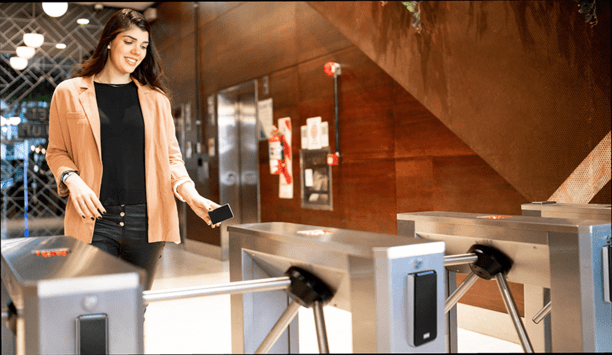
The truth behind 9 mobile access myths
Download
Access control system planning phase 2
Download











